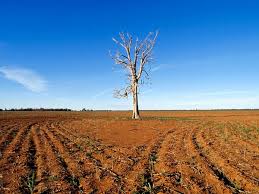 California appears to have moved past the crippling 2014-2016 drought, but the drought actually isn’t over. According to a 2015 study published by researchers from NASA, Cornell and Columbia universities, there is an 85 percent chance of a drought lasting 35 years or more between 2050 and 2100. It will create major water shortages and conditions that dry out vegetation and cause monster wildfires in southern Arizona and parts of California. And a 2018 NASA study reiterates that drier regions of the U.S. (and the world) will just get drier. In short, the current four year drought being experienced by California and other southwestern states is merely a sneak preview forecast for the disturbing weather we can expect in the coming decades.
California appears to have moved past the crippling 2014-2016 drought, but the drought actually isn’t over. According to a 2015 study published by researchers from NASA, Cornell and Columbia universities, there is an 85 percent chance of a drought lasting 35 years or more between 2050 and 2100. It will create major water shortages and conditions that dry out vegetation and cause monster wildfires in southern Arizona and parts of California. And a 2018 NASA study reiterates that drier regions of the U.S. (and the world) will just get drier. In short, the current four year drought being experienced by California and other southwestern states is merely a sneak preview forecast for the disturbing weather we can expect in the coming decades.
“Superdroughts” are nothing new in U.S. history. They occur every 1000 years or so. (North America’s last superdroughts happened in medieval times, during the 12th and 13th centuries.) However, the researchers’ study of tree rings indicated that historically droughts had a 10 percent chance of forming at any time. They were caused by natural changes in weather. But global climate change caused by human activity has supercharged those odds to closer to 85% currently, if nothing is done to reduce CO2 emissions.
This study is the first to examine the future risk of drought in the southwest and central United States in the context of historical episodes of drought in the same regions. The study suggests that the coming years are likely to see droughts worse than the epic dry periods that are thought to have caused profound changes to human settlement in the region over the last millennium. There is good news: the authors indicate that this is a slow-moving natural hazard that humans can manage and possibly ward off. The bad news is that this study is consistent with previous studies that are arriving at similar conclusions. The Washington Post reports that Beverly Law, a specialist in global change biology at Oregon State University’s College of Forestry, co-authored a study of megadroughts three years ago that showed that a drought that affected the American West from 2000 to 2004 compared to conditions seen during the medieval “megadroughts”. She predicted drought this century would be far worse and would largely impact megacities, populations and water availability.
The NASA study just published in Nature goes further. It shows major changes to freshwater availability — changes that could impact water shortages over the course of the century. For the study, published this weekin Nature, scientists drew on 14 years of satellite observations combined with data on human activity to track freshwater trends in 34 regions worldwide. Hydrologist Jay Famiglietti summed it up chillingly: “What we are witnessing is major hydrologic change.”
The additional bad news is that the scope of the predicted superdrought is akin to a superstorm, with its effects being felt through the Western US, including the Great Plains breadbastket. Alhough the ongoing California drought continues to dominate headlines—2014 was the state’s warmest year on record by a wide marginthe researchers found that it is likely that the Midwest’s agricultural businesses will be subjected to the effects of the superdrought. The U.S. Geological Survey has commissioned another study about forest mortality later this century and the preliminary findings are similarly disturbing, with the forecasted amount of precipitation in Arizona being half of what it was between 1950 and 1999.

